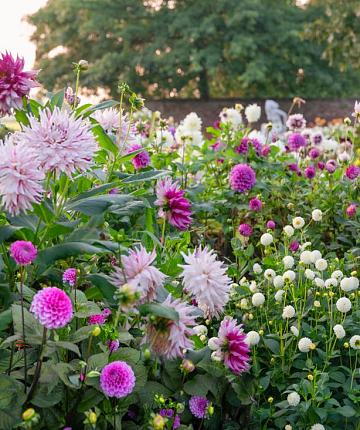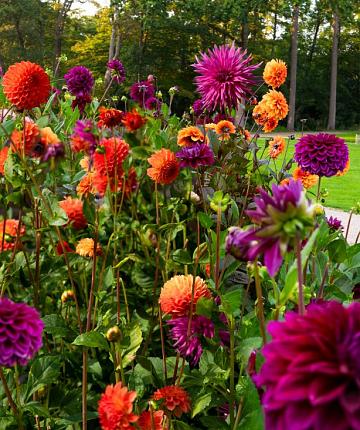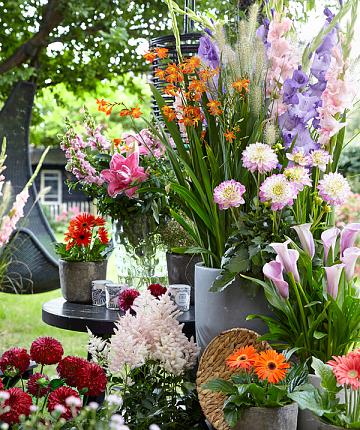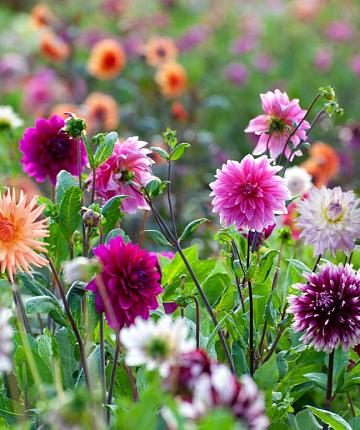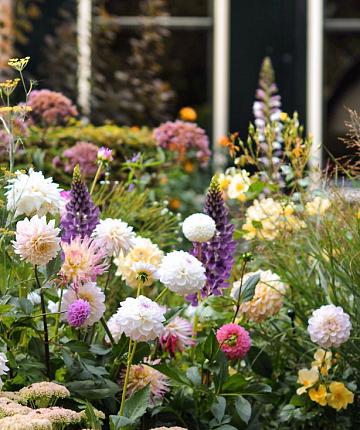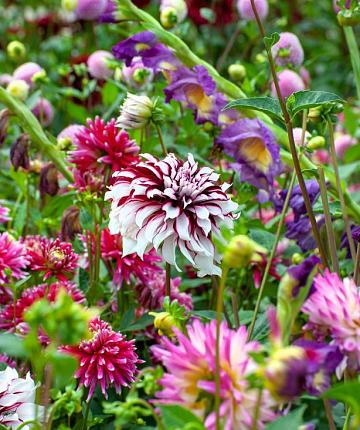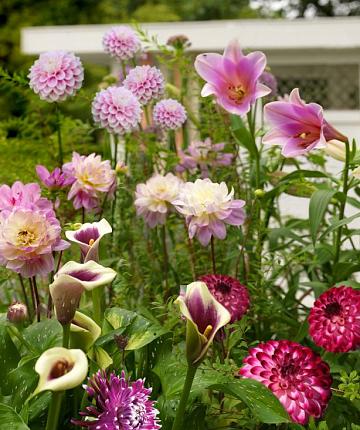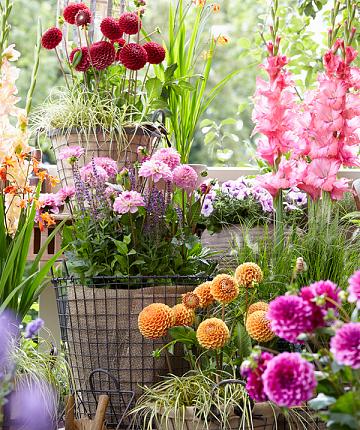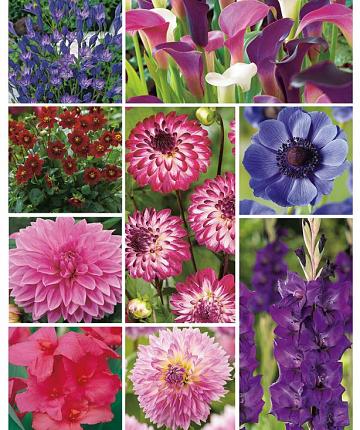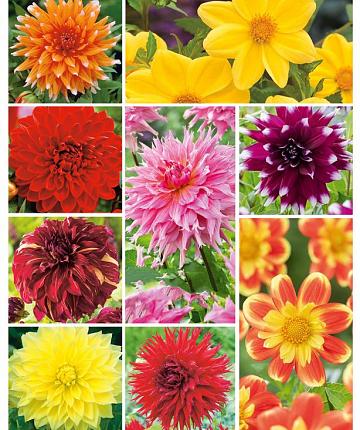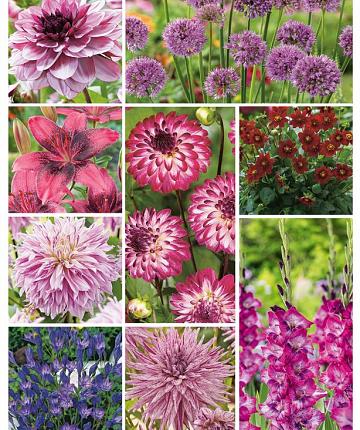Dahlias
.jpg?1660053070=)
The dahlia is a brightly coloured flower that blooms in the summer from June to October. The dahlia originally comes from Mexico and is therefore a real sun worshiper. A dahlia is not hardy, you plant the tuber from April when the chance of frost has gone. Dahlias come in many colours, shapes, types and sizes. The petals vary from plain, striped to even with dots. You have single-flowered but also double-flowered dahlias. These have round, spiky or rolled leaves. Dahlias don’t have a smell.
Not a bulb, but a tuber
Unlike spring flowering bulbs, dahlias are tubers, they are dry elongated tuberous roots. The tubers were first used for food, until the harvested tubers were seen to flower, after which they were named ornamental plants. About 35 wild species can be found in the higher parts of Mexico. Worldwide there are now more than 20,000 cultivated varieties in different colours and shapes and new varieties are added every year. Growers are always looking for new varieties and also try to create new varieties themselves by crossing different dahlia seeds.
Dahlia mania
In 1804 the dahlia came to Europe. When the dahlia became well known, a dahlia mania began in France, just like the tulip mania. A bed of dahlias was sold for 70,000 francs and a dahlia could be exchanged for a diamond. The first dahlia came to the Netherlands in 1872.
Varieties of dahlias
There are many varieties of dahlia tubers. Tubers that give very small flowers such as the 'pom pom' type, but also large flowers that are even bigger than your hand. These are the dinner plate dahlias. You also have dahlias that are perfect for pots because they remain compact, there are species that grow tall and are therefore perfect for planting in a picking garden. Single flowered dahlias where you can clearly see the centre are very attractive to bees and butterflies. The wild dahlias from Mexico have this structure.
Decorative dahlia 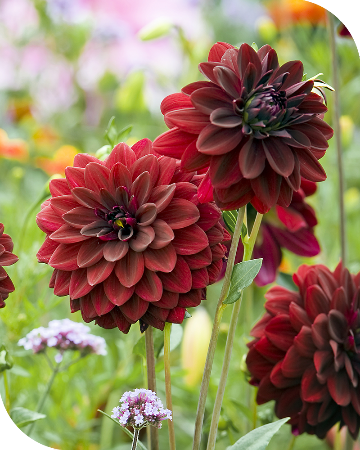
The decorative dahlia has several round petals that together form a beautiful double flower. The petals are somewhat wider and flat and run from round in the center to pointed on the outside. There are many different colour variations of the decorative dahlia. They grow to a height of 70 to 120 cm and have a flower with a diameter of about 15 cm. Dahlia Arabian Night is a decorative dahlia. It has a deep red color and is very suitable for a picking garden. Dahlia Arabian Night can be found in the webshop.
Dinner plate dahlia
The name says it all, the dinner plate dahlia produces flowers, the size of a plate. In terms of shape, the dinner plate is the same as the dahlia decorative, only the flowers are larger. This dahlia class can also be found in different colors and shapes. They are 100 to 150 cm high and have a flower with a diameter of 20 to 30 cm.
Cactus dahlia
Cactus dahlias have many petals, which also makes this dahlia double-flowered. They are also called spider head dahlias. However, the petals are not round but pointed, making the flower look like a cactus. Cactus dahlias come in a variety of colours, even bicolored or striped. They grow to a height of 80 to 150 cm and have a flower with a diameter of 10 to 30 cm.
Fimbriata dahlia
These species are also known as deer-leaved dahlias. They are dahlias with fringed flowers. The petals are pointed with several points at the end. Hence the name deer meadow dahlia. The species comes from the decorative and cactus group. They are 80 to 130 cm high and the flower has a diameter of 10 to 30 cm.
Decorative border dahlia
The decorative border dahlia has the same shape and structure as the decorative dahlia. The flowers and stems of this dahlia are smaller, making it nice and compact for a border. They grow only 40 to 70 cm high and the flowers have a diameter of 10 to 20 cm.
Cactus border dahlia
The same applies to the cactus border dahlia. It resembles the cactus dahlia but is more compact, making it ideal for use in a border or pot. The cactus border dahlias also grow to a height of 40 to 70 cm and the flowers have a diameter of 10 to 20 cm.
Pompon dahlia
The pompon dahlia owes its name to the spherical flowers that resemble cheerleaders pompons. The leaves are very close together and are rolled up like small funnels. The flower is smaller and rounder than the 'ball' dahlias. They have a diameter of about 5-8 cm and are 50 to 100 cm high. This variety is therefore suitable for use in a picking garden.
Mignon dahlia
The dahlia mignon is a single-flowered dahlia because there are only 1 edge of small round petals around the core. The pollen of the dahlia is therefore easily accessible to bees and butterflies. This dahlia is therefore good for biodiversity. They grow to 30-50 cm and come in many different colours.
Anemone dahlia 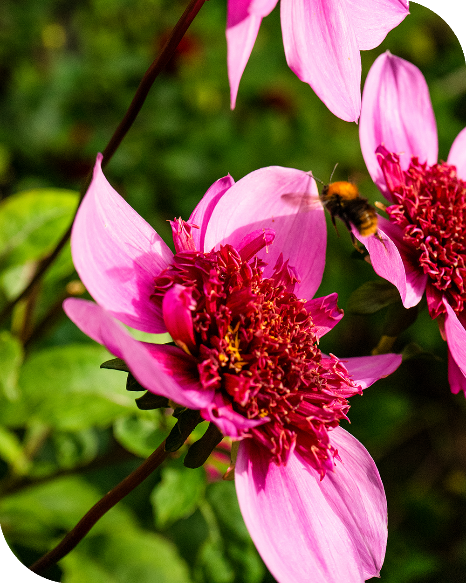
The anemone dahlia is very similar to the flower species anemone. It is a variation with a border of a few petals on the outside and a core of many double petals. They grow to about 40 cm. Characteristics are the striking tubular petals in the center of the flower. Dahlia Blue Bayou is an anemone dahlia. She has a single fringe of purple petals and a dark purple core. Dahlia Blue Bayou is available in the webshop.
Top mix dahlia
Dahlia topmix has many small but single flowers. The flowers have a diameter of about 2 to 3 cm and the plant grows up to 50 cm high. Due to the large number of small flowers, dahlia top mix is ideal for pots or for planting several plants in a border at the same time. The top mix dahlias are also very attractive to bees and butterflies.
Gallery dahlia
The gallery dahlia is similar to the mignon, also compact growing, but this is a double flowered dahlia. This makes the pollen less accessible to bees and butterflies. The gallery dahlia is about 35 cm high and the flower has a diameter of 14 cm.
Ball dahlia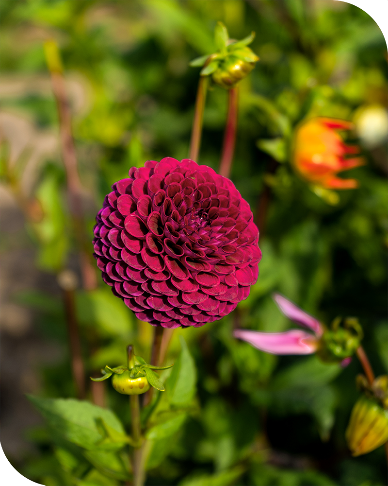
The Ball dahlia is very similar to the Pompon but a bit larger. The ball dahlia is available in many different varieties and colours and grows to a height of about 80 to 100 cm. The diameter of the flower is 8 to 12 cm. Dahlia Jowey Frambo is a raspberry ball dahlia. This is for sale in the webshop.
Plant dahlias
Dahlias are planted from April to May. It is important that you only plant when the risk of frost has gone, otherwise the tuber will freeze. We give you the steps for planting dahlias .
- Choose a sunny position
- Choose a spot with well-drained soil
- Dig a hole about six inches deep
- Make sure the old stem of the tuber is just below the surface
- Fill the hole and give plenty of water
Caring for dahlias
After planting it is important to take good care of your dahlias. With the right steps, your flowers will soon bloom beautifully in the summer. Caring for dahlias is very easy, but it does take some time.
- Water regularly to keep the soil moist
- Pinch out the top growing point when the plant has made 3 to 4 clumps of leaves for a fuller plant
- Give a little fertilizer every month
- Cut away faded flowers to encourage new flower growth
- At the end of the season: when the forst has returned you can cut off the yellow leaves and remove the tuber from the ground
More info? Check out our separate page on caring for dahlias .
Make it bloom!





